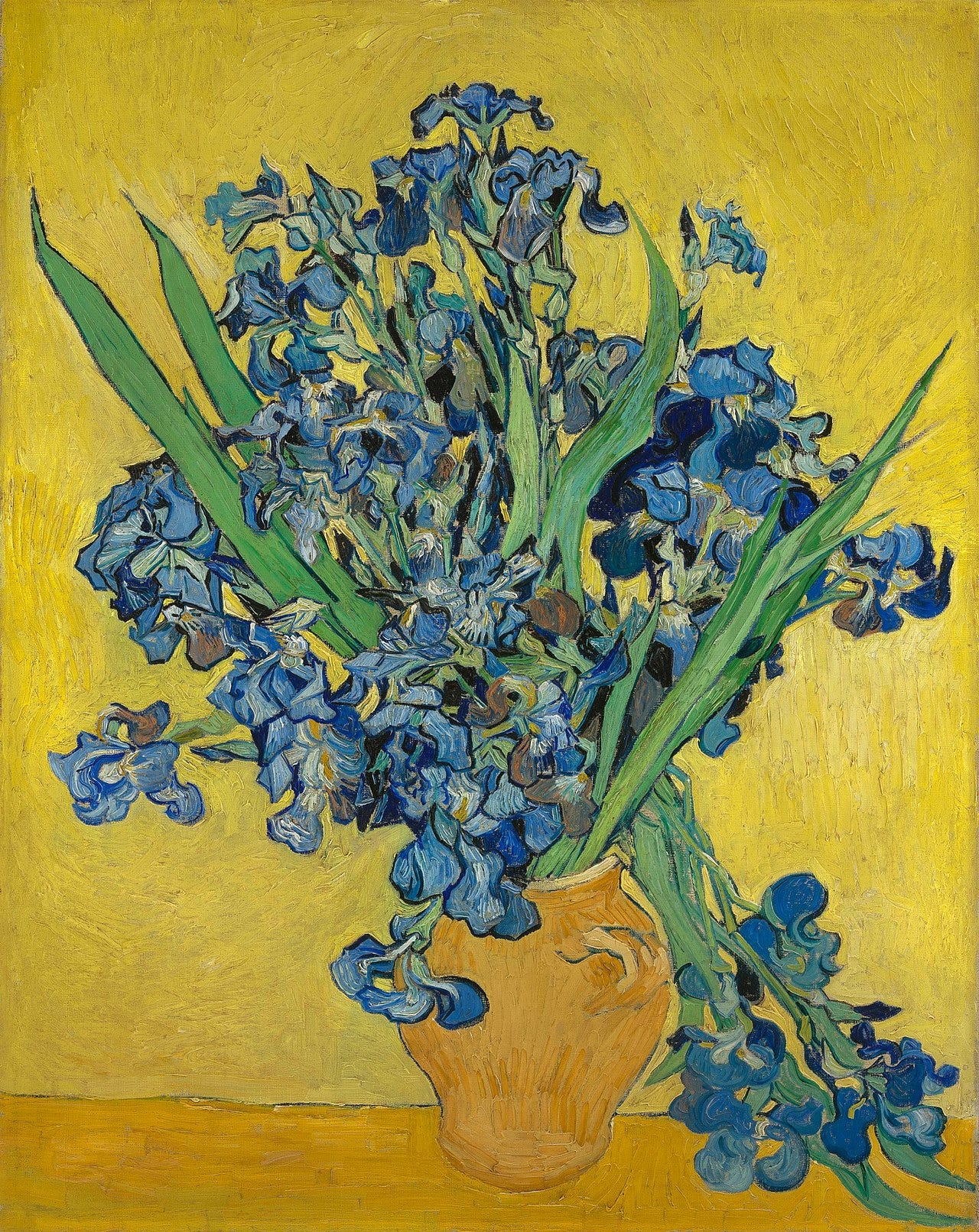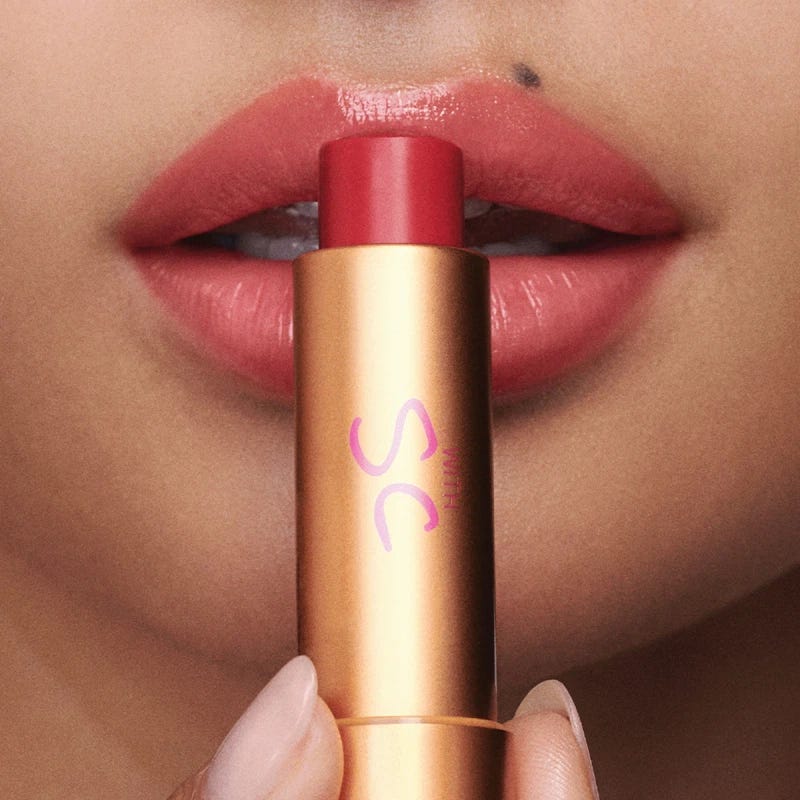My mother came over to help me with the yard the other day. We planted yarrow and marigolds and trimmed the butterfly bush and sprinkled the dirt with worm castings, and then she said, “Why don’t you put that van Gogh in the garden?”
I’ve had a gold-framed print of Vase with Irises Against a Yellow Background, a hand-me-down from my grandmother, leaned up against my kitchen wall for months. I couldn’t figure out a good spot for it. I wouldn’t have thought the garden would be a good spot for it, but I tried it, and it is. Something about the oil-painted irises beside the soon-to-bloom salvia, the real beside the representation — I can’t stop staring out the window at them! I see the beauty of both more clearly. And I think: What if van Gogh sold a product to make all flowers look like his flowers? Some three-step gardening system to fade their vivid purple to his preferred shade of blue, to soften the points of their petals? What if he mass-produced a preservative coating to keep them in a constant state of not-quite-drooping — never fresh, never wilting? What if van Gogh used his representation of the real to convince us the real shouldn’t exist at all; that the real is flawed — wrong and unwell and unworthy — solely on the basis of not being the representation? Isn’t that what the beauty industry does? Doesn’t standardization stand in opposition to art and beauty?
It reminds me of the new collaboration between director Sofia Coppola and skincare brand Augustinus Bader. It’s a trio of tinted lip balms. The products are meant to “enhance lips with a sheer wash” of pink, red, and plum. They’re made with “natural plumping agents” to “lock in moisture so lips appear plumper, smoother and more supple” — lip plumpness is apparently “increased by 15%” — as well as ingredients “capable of addressing individualized concerns, such as the appearance of fine lines and wrinkles.” Buy one and you’ll also get free samples of Augustinus Bader Serum (“for more youthful looking skin”) and Face Cream Mask (which “lifts, tightens and firms skin on the face and neck”). I admire Coppola’s films: The Virgin Suicides, Marie Antoinette, Priscilla. I like how she uses the aesthetics of female adolescence to draw the audience into the turmoil of female adolescence. But this collaboration corrupts that. Compromises it, cheapens it. Does art about the gilded cage of girlhood have merit if the artist is selling the gilding? If she seeks to hold you there by the taut skin of your neck?
“It’s an art form,” Kim Kardashian said of breathing in the corseted gown she wore to the Met Gala last week. From Rollo May’s The Courage To Create: “In [Plato’s] later, beautiful dialogue, the Symposium, he described what he called the true artists — namely, those who give brith to some new reality … As I would put it, these are the ones who enlarge human consciousness.” The ability to inhale in spite of squeezing your internal organs is not art, of course. It doesn’t break from the given, or bring anything new into being. This is the “crucial distinction,” May writes, “between art as artificiality (as in ‘artifice’ or ‘artful’) and genuine art.”
I know this was an offhand comment from Kardashian, but I would argue her overall Met Gala look by John Galliano for Margiela wasn’t art, either. Was it even fashion? Or beauty? Fashion and beauty are forms of adorning the body, I think, and Kardashian is more interested in manipulating (mutilating?) the body for the sake of encouraging mass replication of her manipulated body, and this for the sake of profiting off that replication (in ways both abstract, like publicity, and concrete, like selling waist trainers, which she does through her shapewear brand SKIMS). It’s true that a hallmark of beauty is that it inspires replication — van Gogh’s replicated irises, for example — but “when a legion of people begin to style themselves after a particular movie starlet,” Elaine Scarry writes in On Beauty and Being Just, it is “an imperfect version of a deeply beneficent momentum toward replication”; imperfect because it has no benefit. It does not enhance, but degrades. It does not expand human consciousness, but dehumanizes. Kardashian and the industries that bore her and support her reduce the body to something like fast fashion: suction the fat when it doesn’t suit, remove the ribs, reverse the BBL. (These procedures are rumors for Kardashian, but reality for many who imitate her form.) Cosmetic medical waste is piling up like clothing in landfills, and whatever “gives rise to material cupidity” is not beauty, said Scarry, but an “error” in pursuit of it.
Where is the line? I look at my garden and see beauty in the real and beauty in the representation. If the latter is commodified in ways that devalue the former, I don’t think I can call it art or beauty.






jessica, this is one of my favorite pieces from you yet. I was thrilled to discover I have a lilac bush in my yard (this is my first spring in my first house!), and I found myself looking up lilac-scented candles to try to hold on to the scent even after the blooms are gone. but I realized I was spending time trying to find the perfect one instead of just… enjoying the real thing while it’s here. there’s nothing wrong with representations, as you said, and I may still buy a candle during the depths of winter when I need a reminder that spring is coming. but it’s no replacement for the real thing. 💜
That little phrase ,,individualized concerns" from the ad makes me so sad. Nothing about these ,,concerns" is individual. In fact, they aren't even concerns. They're a collective, commodified delusion.